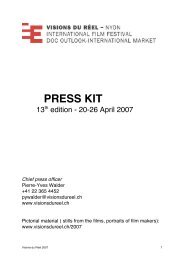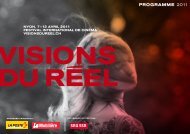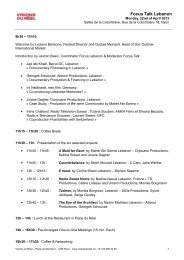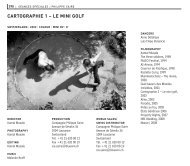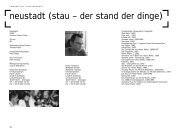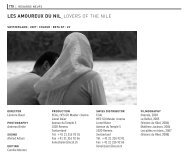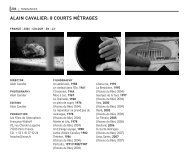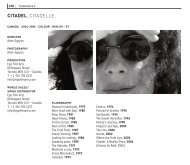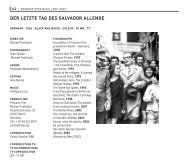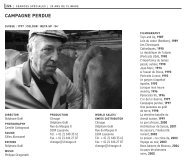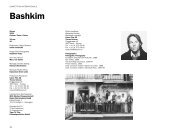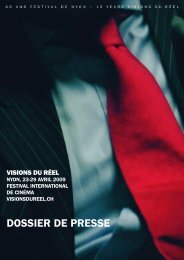Katalog 2013.pdf - Visions du Réel
Katalog 2013.pdf - Visions du Réel
Katalog 2013.pdf - Visions du Réel
You also want an ePaper? Increase the reach of your titles
YUMPU automatically turns print PDFs into web optimized ePapers that Google loves.
compétition internationale – moyens métrages<br />
79<br />
Bartek Konopka, Piotr Rosolowski<br />
Sztuka<br />
Znikania<br />
Poland | 2013 | 50’ | HD | Creole<br />
The Art of Disappearing<br />
World Premiere<br />
En 1980, à la suite d’une visite à Haïti<br />
<strong>du</strong>rant laquelle il assiste à une cérémonie<br />
de possession, le metteur en scène<br />
polonais Jerzy Grotowski invite Amon,<br />
un prêtre vaudou, à rentrer avec lui en<br />
Europe, pour le faire participer à un<br />
laboratoire théâtral. En Pologne, le vent<br />
de la liberté souffle fort, mais la répression<br />
<strong>du</strong> régime se rapproche. Amon fait<br />
l’expérience de ce nouveau pays, de ses<br />
habitants, de leurs us et coutumes. Il<br />
voit la mortification d’un peuple soumis<br />
au pouvoir. C’est alors que le souvenir<br />
de ses ancêtres, des déserteurs polonais<br />
de l’armée de Napoléon qui contribuèrent<br />
à libérer Haïti de l’esclavage, lui<br />
inspire un sentiment de reconnaissance.<br />
Il devra aider les Polonais… à tout prix.<br />
Basé sur un fait réel et des images strictement<br />
documentaires, le film adopte un<br />
dispositif de fiction. Après un prologue<br />
qui témoigne de l’existence <strong>du</strong> mystérieux<br />
Amon, le film plonge dans un<br />
récit à demi halluciné sur le motif des<br />
« Lettres persanes », où le prêtre commente<br />
en direct les images d’archive,<br />
avec un rapprochement final entre l’agonie<br />
de la dictature haïtienne de Duvalier<br />
et celle <strong>du</strong> régime communiste. Un exercice<br />
d’exorcisme marqué par une ironie<br />
certaine.<br />
1980 lädt der polnische Regisseur Jerzy<br />
Grotowski nach einem Besuch Haitis,<br />
wo er einer Besessenheitszeremonie<br />
beiwohnte, den Voodoo-Priester Amon<br />
ein, mit ihm nach Europa zurückzukehren,<br />
wo er ihn in ein Theaterprojekt einbeziehen<br />
wollte. Der Wind der Freiheit<br />
weht stärker in Polen, doch auch die<br />
Repression <strong>du</strong>rch das Regime rückt<br />
näher. Amon erlebt ein neues Land mit<br />
seinen Einwohnern und ihren Sitten<br />
und Gebräuchen. Er sieht die Kasteiung<br />
eines Volkes. Und in Dankbarkeit<br />
erinnert er sich, dass seine Vorfahren –<br />
Deserteure der napoleonischen Armee<br />
– dazu beigetragen haben, die Sklaverei<br />
in Haiti abzuschaffen. Er muss den Polen<br />
helfen… um jeden Preis. Der auf einer<br />
wahren Begebenheit und streng dokumentarischen<br />
Bildern basierende Film<br />
übernimmt eine Technik des Spielfilms.<br />
Nach einem Prolog, der die Existenz der<br />
geheimnisvollen Figur Amon bezeugt,<br />
taucht der Film in einen halb halluzinatorischen<br />
Bericht nach dem Modell der<br />
«Persischen Briefe» ab, in dessen Verlauf<br />
der Priester die Archivbilder direkt kommentiert<br />
und abschliessend eine Parallele<br />
zwischen dem Todeskampf der<br />
Diktatur im Haiti Duvals und dem kommunistischen<br />
Regime zieht. Der Versuch<br />
eines klar ironischen Exorzismus.<br />
In 1980, following a visit to Haiti <strong>du</strong>ring<br />
which he witnessed a possession<br />
ritual, the Polish theatre director Jerzy<br />
Grotowski invited Amon, a voodoo priest,<br />
to return with him to Europe to participate<br />
in a theatrical laboratory. The winds<br />
of freedom were blowing strong in<br />
Poland, but the repression of the regime<br />
was drawing close. Amon experienced<br />
this new country, its inhabitants, habits<br />
and customs. He saw the humiliation of<br />
a people submissive before power. This<br />
is when the memory of his ancestors,<br />
Polish deserters from Napoleon’s army<br />
who helped liberate Haiti from slavery,<br />
inspired sentiments of recognition. He<br />
felt compelled to help the Polish… at<br />
all costs. Based on a real incident and<br />
on strictly documentary images, the film<br />
adopts a fictional device. After a prologue<br />
attesting to the existence of the<br />
mysterious Amon, the film plunges into a<br />
semi-hallucinatory account following the<br />
motif behind “Persian Letters”, where the<br />
priest comments directly on the archive<br />
images, with a final connection between<br />
the agony of Duvalier’s Haitian dictatorship<br />
and that of the communist regime.<br />
An exercise in exorcism stamped by a<br />
certain irony.<br />
Luciano Barisone<br />
Screenplay<br />
Piotr Rosołowski,<br />
Bartek Konopka<br />
Cinematography<br />
Piotr Rosołowski<br />
Editing<br />
Andrzej Dabrowski<br />
Sound<br />
Franciszek Kozłowski<br />
Music<br />
Maciej Cieslak<br />
Pro<strong>du</strong>ction<br />
Paweł Potoroczyn<br />
(Instytut Adama Mickiewicza),<br />
Anna Wydra (Otter Films)<br />
Filmography<br />
Bartek Konopka<br />
2013 The Art of Disappearing<br />
(mlf)<br />
2011 Fear of Heights<br />
2009 Rabbit à la Berlin (mlf)<br />
2008 Three Buddies<br />
2006 Three for the Taking (mlf)<br />
2004 Goat Walker (mlf)<br />
2003 Sky over Europe<br />
Piotr Rosołowski<br />
2013 The Art of<br />
Disappearing (mlf)<br />
2011 The Mole<br />
2010 Little Bride<br />
2009 Rabbit à la Berlin (mlf)<br />
2007 On the Line<br />
Contact<br />
Anna Wydra<br />
New Europe Film Sales<br />
docs@neweuropefilmsales.com<br />
www.neweuropefilmsales.com



